It may say the loads are unfactored, but dig a little deeper to see if they specifically mention ASD or LRFD (or LSD, if this is a Canadian job - I think I remember you saying your employer handles both). They provide it unfactored so you can run your own load combinations. Those combinations should, however, be the same ones they used to design the building. If the didn't specify, send an RFI. skeletron is right about LRFD/LSD - if you're in Canada or Europe. There are still a whole lot of engineers in the US that are holding on to ASD for dear life.
If they said 50% of UDL, that's what they get. I believe the code of standard practice specifically states that it's not your job to give them a peer review. That said, don't go through it with your eyes closed. If you come to a beam that has another beam framing into it really close to the end, give it some thought. I've seen a few "50%" beams that wound up with connections that were too weak because the load was concentrated to one end of the beam. The other thing to look for is really short beams. The UDL will max out to the shear capacity of the member if they get short enough, and designing a shear tab to meet the full shear capacity of a member is usually pretty silly.


